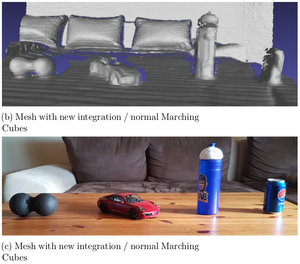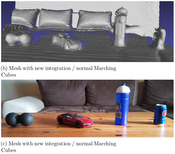Information
- Publication Type: Bachelor Thesis
- Workgroup(s)/Project(s):
- Date: March 2021
- Date (Start): 16. March 2020
- Date (End): 1. March 2021
- Matrikelnummer: 01632716
- First Supervisor: Stefan Ohrhallinger
- Keywords: 3d scanning, scan integration, geometry processing
Abstract
3D scanning is often not complete after a single pass from a single sensor. Multiple scanners, e.g. from a crowd, or multiple autonomous vehicles, may contribute data simultaneously. Or, after looking at the resulting model, more passes may be made to fill holes or improve the quality.This requires updating a 3D reconstruction with new points, integrating those into the model and considering them equally with the existing points. In order to avoid dynamic and massive storage requirements, their coordinate information required for reconstruction can be stored as single median+variance vectors, which can be updated incrementally with new points, see e.g.: http://datagenetics.com/blog/november22017/index.html). With the local information at nodes, marching cubes can be used to generate a triangulation at grid cells. Since the octree has varying depths at leaf nodes, we need to apply an adapted version from an existing algorithm, Screened Poisson (for source and paper see: http://www.cs.jhu.edu/~misha/Code/PoissonRecon/Version8.0/). See also http://infinitam.org for the source code and the paper it is based on.
Tasks: Use a Kinect 3D scanner with the Infinitam software to scan several overlapping passes of an interior room, resulting in an octree with data in its nodes Hand-align scans with Meshlab or register them using ICP (http://pointclouds.org/documentation/tutorials/iterative_closest_point.php) so that they correspond spatially Add new points into octree nodes which overlap in space Apply a provided surface orientation operator which uses median+variance of nodes in order to mark vertices of nodes as in- or outside Create a mesh from the octree on demand for visualization, using marching cubes adapted to octrees as in Screened Poisson Evaluate the quality of the incrementally created reconstruction with a single-pass reconstruction of a merged point cloud where all points are considered at once
Additional Files and Images
Weblinks
BibTeX
@bachelorsthesis{depner_dennis-2020-baa,
title = "3D Scan Integration",
author = "Dennis Depner",
year = "2021",
abstract = "3D scanning is often not complete after a single pass from a
single sensor. Multiple scanners, e.g. from a crowd, or
multiple autonomous vehicles, may contribute data
simultaneously. Or, after looking at the resulting model,
more passes may be made to fill holes or improve the
quality. This requires updating a 3D reconstruction with
new points, integrating those into the model and considering
them equally with the existing points. In order to avoid
dynamic and massive storage requirements, their coordinate
information required for reconstruction can be stored as
single median+variance vectors, which can be updated
incrementally with new points, see e.g.:
http://datagenetics.com/blog/november22017/index.html). With
the local information at nodes, marching cubes can be used
to generate a triangulation at grid cells. Since the octree
has varying depths at leaf nodes, we need to apply an
adapted version from an existing algorithm, Screened Poisson
(for source and paper see:
http://www.cs.jhu.edu/~misha/Code/PoissonRecon/Version8.0/).
See also http://infinitam.org for the source code and the
paper it is based on. Tasks: Use a Kinect 3D scanner
with the Infinitam software to scan several overlapping
passes of an interior room, resulting in an octree with data
in its nodes Hand-align scans with Meshlab or register
them using ICP
(http://pointclouds.org/documentation/tutorials/iterative_closest_point.php)
so that they correspond spatially Add new points into
octree nodes which overlap in space Apply a provided
surface orientation operator which uses median+variance of
nodes in order to mark vertices of nodes as in- or outside
Create a mesh from the octree on demand for visualization,
using marching cubes adapted to octrees as in Screened
Poisson Evaluate the quality of the incrementally
created reconstruction with a single-pass reconstruction of
a merged point cloud where all points are considered at once
",
month = mar,
address = "Favoritenstrasse 9-11/E193-02, A-1040 Vienna, Austria",
school = "Research Unit of Computer Graphics, Institute of Visual
Computing and Human-Centered Technology, Faculty of
Informatics, TU Wien ",
keywords = "3d scanning, scan integration, geometry processing",
URL = "https://www.cg.tuwien.ac.at/research/publications/2021/depner_dennis-2020-baa/",
}

 paper
paper

